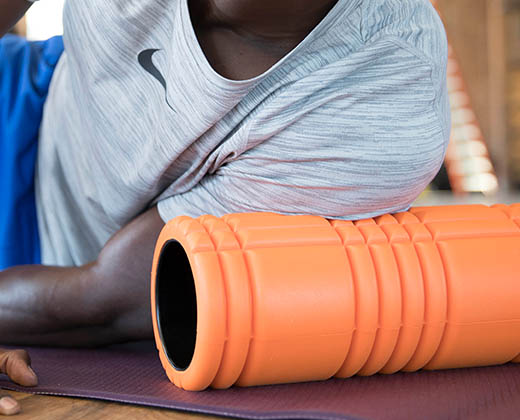Hip Mobility Stretches for Baseball and Softball Training
Learn how to warm up your hips and help improve your performance with these in-depth training tips.
For baseball and softball players, your hips are very important to having success on the field. Not only are they used when you’re running, but they’re also pivotal in your throwing motion. This means it’s essential to make sure your hips are loose and warmed up before training.
Your hips rotate both internally and externally, according to Frank Velasquez, director of sports performance for Allegheny Health Network, and there are multiple exercises you can perform to ensure that you are mobilizing this key area. “You need to be able to internally rotate to get through the ball to throw it to allow your entire body to work,” he says.
Starting with internal rotation, sit on the ground with your knees bent in front of you. Be sure to rest on your heels. Rotate your hips from side to side for a few repetitions, pausing with your knees on your left. Next, Velasquez says to put your bottom foot over your top knee. This move is to help stretch your hip’s internal rotator on the opposite side.
After a few seconds of stretching, unhook your top foot and rotate to the other side. Lock in again for a complete internal rotation routine. Velasquez notes that you can perform this exercise sitting up or lying down on your back.
Your final exercises for baseball and softball hip mobility should be hurdle walkovers. To do these, you will need five or six hurdles placed in line with enough room to maneuver through. For your first exercise – the front walk – position yourself in the center of the hurdles at the start of the line. Begin with a high step over the hurdle and repeat at each one. Your steps, according to Velasquez, should be “straight ahead, making sure [your] foot comes over the hurdles, not around.” Alternate which leg goes first.
Once you’ve completed a round of front walks, you can move into your backward walk exercise. This is the same format as your front walk, except in reverse. Velasquez stresses to open your hips as you go.
After backward walks, turn your body to have the hurdles at your side and complete a round of side steps. Bring your lead knee over the structure, following with the other knee. You should perform two rounds of side hurdle walks – one leading with your right leg and one leading with your left.
Your next hurdle exercise for hip mobility should be what Velasquez calls “foot flips.” To complete this internal rotation movement, stand staggered to one side of the hurdles. From this stance, when you step, only one leg should clear the structure. As you walk through the hurdle line, bring your knee over the bar and follow with your foot. Flip your foot over the hurdle, focusing on your right leg one way, then the left the other, according to Velasquez.
Following your foot flips will be your dances. In this exercise, you will high-kick from one end of the hurdles to the other, bringing each leg over every hurdle. In addition to working on your hip mobility, your dance hurdle routine can also put some groove in your step. This is a very good exercise because athletes need to have rhythm, Velasquez explains. “Good athletes have rhythm.”
Your final hurdle exercise to round out your hip mobility program for baseball and softball strength training will be your over-unders. This exercise will require you to modify some hurdles by adjusting their height. Raise every other hurdle so that there is ample room to maneuver under them. To begin your over-unders, lead with your right knee over the hurdle, following with the left. Next, drop into a squat position and step under the second hurdle, again leading with your right leg. Stand up and repeat the over-under movement, alternating your lead foot, until you’ve reached the end of the line.
These hip mobility exercises for baseball and softball training can help get your hips loose and limber for your next training day. Use these drills to get your body ready to perform from the first pitch to the final out.
You can also take some time during your baseball and softball training routine to focus on other key areas that require some limbering up, including your thoracic spine.








